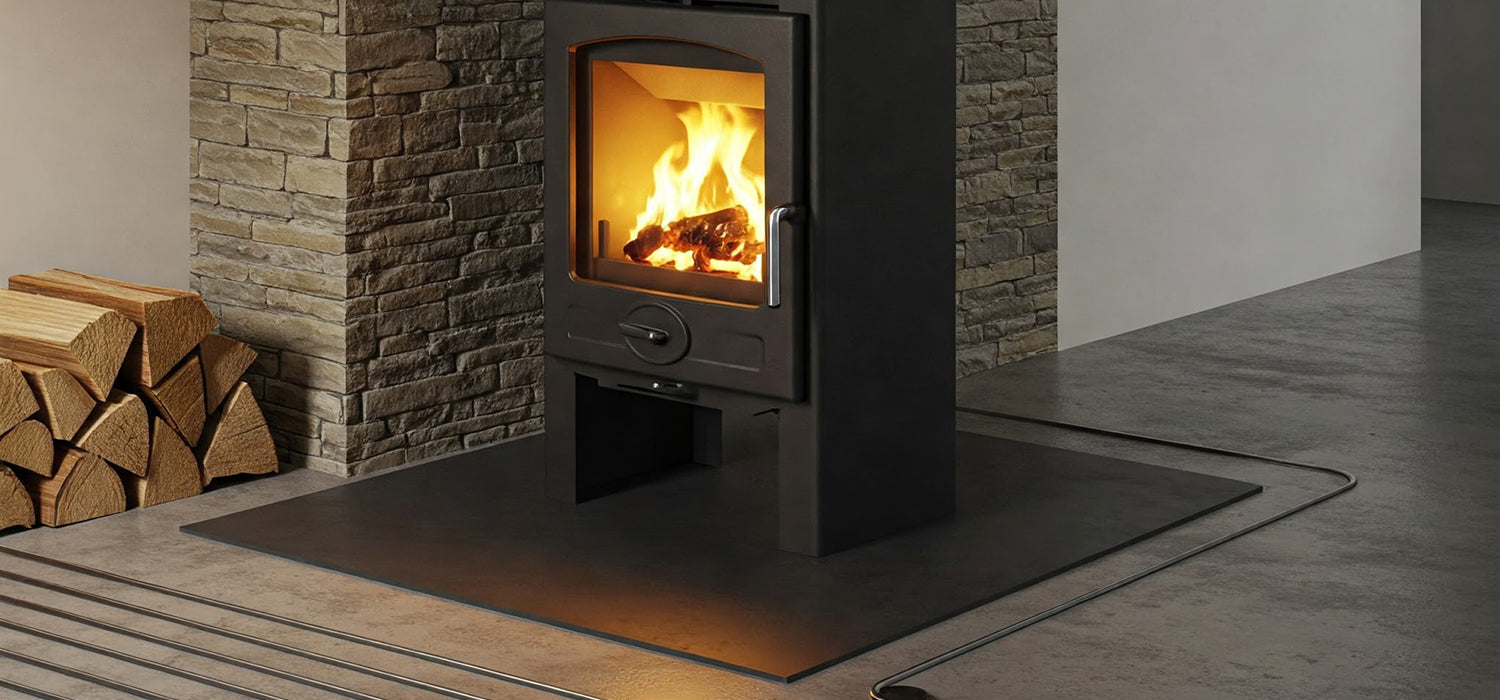
Can You Have a Log Burner with Underfloor Heating?
Can you have a log burner with underfloor heating? Short answer: absolutely! Imagine toasty toes and crackling fire vibes—yes, you can have both. But before you choose what log burner to buy or crank the heat, there are a few smart tips to keep things cosy, safe, and efficient. Keep reading!
Compatibility of Log Burners and Underfloor Heating Systems
Mixing a modern underfloor heating system with the old-school charm of a log burner might sound like a heating identity crisis. But truth is, it’s a combo that works brilliantly when done right.
You get gentle, consistent heat across your room, plus that instant comfort and atmosphere from the fire. It’s not just possible—it’s becoming increasingly popular in British homes, especially during renovations and self-builds.
Done properly, these two systems can complement each other rather than clash.
Different Heating Zones and Control
Think of your home like a well-orchestrated band. Underfloor heating is the background rhythm—subtle, steady, keeping the warmth flowing. The log burner? That’s the lead guitar. It comes in strong when needed and steals the show on cold winter nights.
Having separate zones for each system means you’re not relying too heavily on one. For example, let the underfloor heating tick over quietly through the day, and light the log burner when you settle in for the evening. It’s efficient, flexible, and oh-so-cosy.
Potential for Overheating
It’s easy to get carried away with both systems on full blast. But that can lead to one common issue—overheating.
Imagine this: your log burner’s glowing, chucking out loads of heat. Meanwhile, the thermostat controlling your underfloor heating is picking up that warmth and switching off early. The far side of the room stays chilly while the area near the burner becomes a sauna.
The trick is to separate their controls and position your thermostats wisely. More on that shortly.
Considerations for Installation
Pairing a log burner with underfloor heating isn’t as simple as plugging in a heater and hoping for the best. It’s worth planning ahead—especially if you’re already mid-renovation or working on a new build.
Impact on Heat Distribution
Underfloor heating warms a room evenly, spreading low-temperature heat across a wide surface. A log burner, on the other hand, is like a spotlight—it heats fast and strong, but only in its immediate zone.
That’s why placement matters. Put your stove too close to the thermostat, and it could throw off the balance. In open-plan rooms, it’s common to use the burner for atmosphere and top-up warmth, while relying on the floor system for all-day comfort.
A small fan or open vents can help circulate the heat more evenly—especially in larger spaces.
Considerations for Different Floor Types
Flooring can make or break your heating setup. Underfloor heating works beautifully with stone, tile, or engineered wood. These materials conduct heat well and won’t mind being warmed from below.
Add a log burner to the mix, though, and you’ve got to be more careful. Real wood flooring, for example, might expand or warp if it's exposed to concentrated heat near the stove. And thick rugs? Lovely underfoot, yes—but they block heat from rising effectively.
Your installer will guide you on the best flooring to match your system—and where to avoid putting furniture or coverings that mess with airflow.
Thermostat Placement and Control
Here’s where things can go sideways if you’re not careful. A poorly placed thermostat could cause chaos—switching off the heating too soon, or keeping it running longer than necessary.
Keep thermostats well away from the log burner and out of direct sunlight or draughts. Ideally, you’ll want each heating system on its own control. That way, you avoid one affecting the other.
Smart thermostats and zoning systems are brilliant for this. They allow you to fine-tune temperatures and timings, making the most of both heat sources without clashing.
Case Studies and Examples of Combined Systems
Open-Plan Living, Yorkshire
Tom and Sarah renovated their farmhouse with underfloor heating across the ground floor. They installed a compact log burner in the living room for chilly evenings. “We use the floor heating during the day, and light the fire after tea—it’s perfect,” Sarah says.
Garden Room Extension, Kent
A newly built garden room struggled to warm up in the early mornings. Fitting a small stove solved the issue. The underfloor system keeps a steady base temperature, and the burner heats the space up quickly when needed.
Cottage Conversion, Cornwall
In a stone-built cottage with thick walls, underfloor heating keeps the chill off, but the owners found it took a while to really feel warm. Adding a mid-sized log burner gave them instant warmth and cut their reliance on the radiators.
Expert Advice on Integrating Log Burners and Underfloor Heating
Heating professionals agree—this combo can be fantastic when carefully planned.
Here’s what they recommend:
-
Start early. If you’re renovating, speak to a heating engineer and a HETAS-registered stove installer from the beginning.
-
Balance your systems. Let the underfloor heating handle background warmth and use the stove for top-ups.
-
Invest in good controls. Smart thermostats or zoned systems let you avoid conflicts and fine-tune temperatures.
-
Choose the right stove. When deciding what log burner to buy, don’t go too big. Oversized stoves can overheat small rooms. Look for one matched to your room’s size and insulation levels.
-
Ventilation is vital. A log burner needs proper airflow to burn cleanly and safely. Make sure your setup complies with UK Building Regulations and HETAS standards.
Final Thoughts
So, can you have a log burner with underfloor heating? You absolutely can—and it might just be the coziest combination going.
Done right, you get the comfort of warm floors, the instant heat of a fire, and a beautiful centrepiece for your living space. Whether you’re mid-reno or dreaming up a new build, take the time to plan the setup properly. Speak to professionals, think about layout and control, and don’t skimp on the details.
And when it’s done? Pour a cuppa, pop your slippers on, and bask in the warm glow of clever heating.
Other content we think you'll love
- What Log Burner Do I Need? The Cosy Homeowner’s Guide
- What Log Burner to Buy: The Cosy Homeowner's Guide
- How to Remove a Wood Stove: A Step-by-Step Guide
- How to Fit a Log Burner (Without Setting Off the Smoke Alarm)
- What Size Log Burner Do I Need? A Simple Guide to Finding the Perfect Fit
- Where to Put a Log Burner: Finding the Perfect Spot for Warmth and Style
- Can You Take a Log Burner When You Move? Here's What You Need to Know
- How to Fit a Wood Burner in a Conservatory
- Log Burner for New Build: What You Need to Know Before You Install One
- Installing a Log Burner Near a Gas Pipe: What You Need to Know
- Log Burner Near Curtains: How Close Is Too Close – And How to Stay Safe
- Can You Use a Log Burner Without a Liner?
- Log Burner Distance from Combustibles: Stay Safe and Warm

